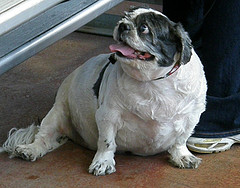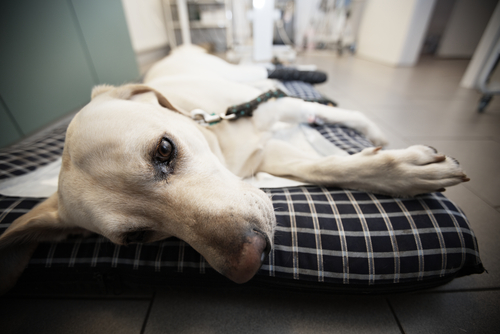
Have you heard of bloat? If you’ve got a dog at home, this disease is something you should learn about. In humans, bloat, also known as gastric dilatation-volvulus (GDV) complex, is pretty harmless. For dogs, the disease can be extremely dangerous.
Take some time to educate yourself and you’ll be prepared for indicators of trouble.
What is bloat?
Dr. Anna Stobnicki, DVM, a surgical intern at an emergency animal hospital in Idaho told PetMD, “GDV is a condition where the stomach twists and then fills with gas. Or the other way around—no one is sure whether it bloats then twists, or twists then bloats.”
Whether the twisting or the bloat comes first, either way, this is not a good scenario for your pup. As the dog’s stomach fills with air, pressure builds. This pressure prevents blood from the back legs and abdomen from returning to the heart. So, blood gathers at the back end of the dog’s body, lessening the blood volume and sending the dog into shock.
A study from Tufts University identified bloat as the top cause of death for several large and giant breeds. According to the research, Great Danes have the highest likelihood of experiencing bloat. Bloodhounds, Irish Wolfhounds, Irish Setters, Akitas, standard Poodles, German Shepherds, and Boxers are other breeds at a higher than average risk of having a bloat episode.
However, all dogs can experience bloat. It’s important that you know the signs.

What are the symptoms?
Like in humans, one of the signs of bloat is pretty simple to notice quickly. A swollen belly indicates some level of the disease. Your dog may also pant or display signs of restlessness. Another symptom to watch out for is if your pup is retching but unable to vomit.
You may recognize your dog making the sounds he typically does when he is in pain. Another sign of the disease is increased salivation or lots of drool. If your dog is experiencing the disease, she may whine or react negatively if you press on her belly.
If you don’t catch the symptoms quickly, this awful disease could lead your dog to collapse.
What should you do?
Here’s the scary part. The study from Tufts says if the painful disorder isn’t treated within one to two hours it could be life threatening to your dog. If you notice your dog exhibiting any of the symptoms above, get your pup to her vet straight away. Bloat cannot be treated at home.
When in doubt, call your vet or a local emergency pet hospital. No matter what, don’t “wait and see.” Concerns of bloat should be taken very seriously.
How is this disease treated?
The first thing your vet will do is assess the severity of the disease. Your vet will do a physical exam and take X-rays. The doctor will also most likely do a blood test. Once bloat is diagnosed, surgery is the only way to treat the condition. According to the American Kennel Club, the doctor will deflate and untwist your pup’s stomach. If any parts of your dog’s stomach were harmed, they will remove them. The vet will also likely tack parts of the stomach to the abdominal wall to prevent your dog from having the condition again.
After the surgery, your pup will need to rest to make sure they heal properly.
Treatment for bloat is complex and must be administered by a trained professional.
Can you prevent bloat?
First, there are some risk factors to know. Any dog can get this disease, however, some are more susceptible to it. The same Tufts study found dogs with the greatest risk of developing bloat have chests that are deep and narrow (like Great Danes). The study also showed that lean dogs were at higher risk than overweight dogs. Older dogs also have a higher risk.
If possible, find out if any of your dog’s relatives suffered from bloat. If their siblings or parents had the disease, it could be a signal your pup is at risk.
These are some preventative measures you can take:
- Give your dog several small meals a day
- Try not to give her brisk exercise after a large meal
- Keep your pup from eating garbage or other food that may give him gas
- Help your dog eat slower with an interactive food bowl

Educate yourself and watch for symptoms
Even if you take all the preventative steps, your dog may still have a bloat episode. The most important thing to remember is if you fear your pup has the disease, get them to the vet as soon as possible. Do not wait. This condition is extremely dangerous. Don’t be frightened, be empowered with the knowledge you gained from reading this article. You can help your dog if they encounter this serious condition. Take them straight to their veterinarian.
The post Everything You Need to Know About Bloat – The Deadly Dog Disease appeared first on iHeartDogs.com.
from iHeartDogs.com https://ift.tt/2W8N3Fx https://ift.tt/2W8NiQX





No comments:
Post a Comment